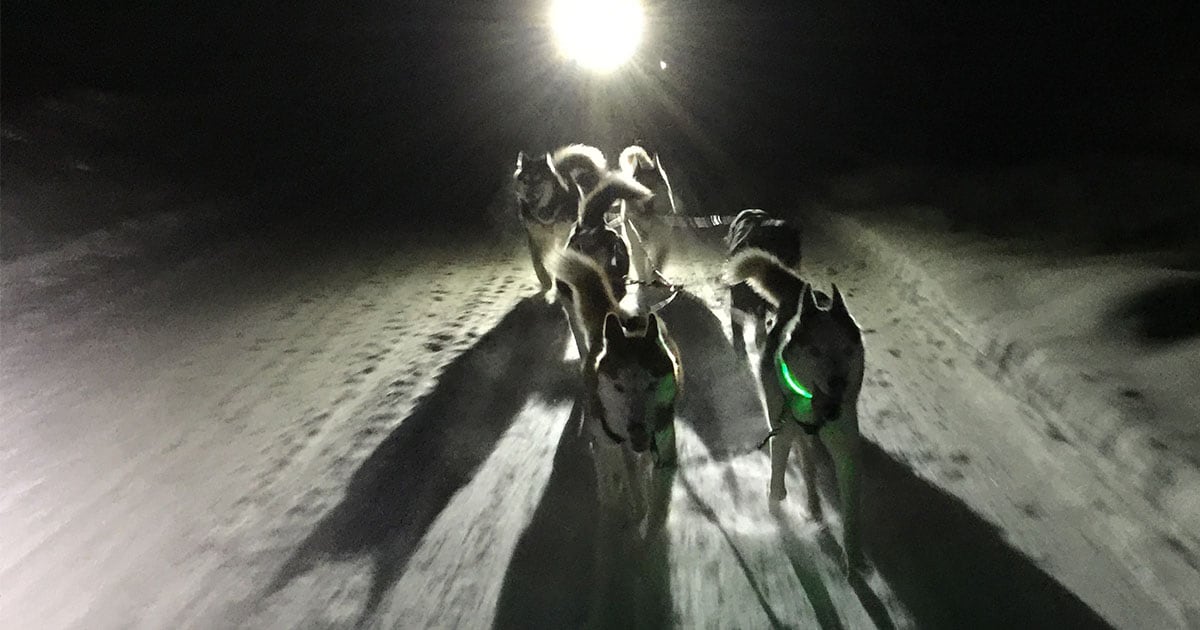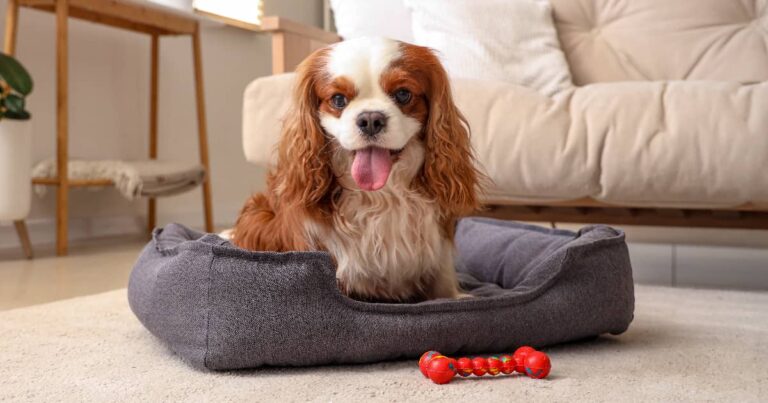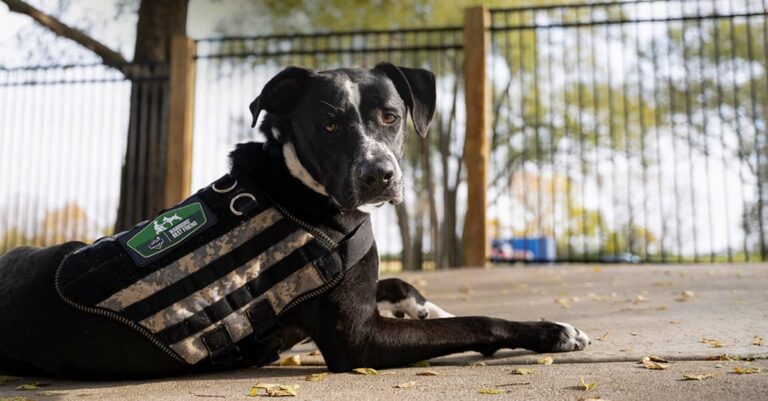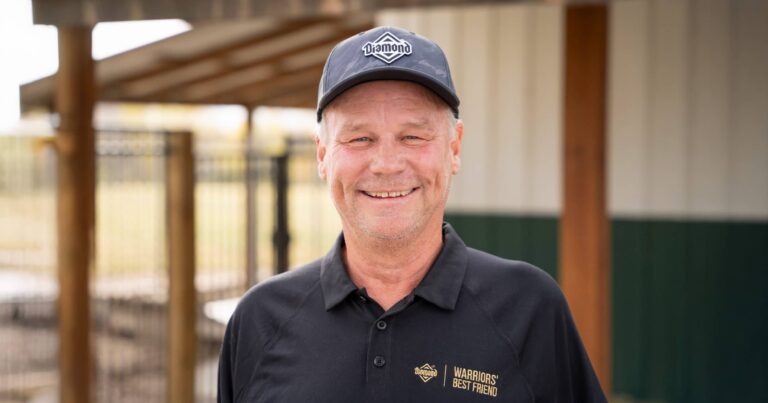The Breakaway Siberians are sled dogs that live and train in and around St. Louis, Missouri. The team is made up primarily of rescued Siberian huskies that have been adopted by Richie and Leah Camden. In May 2016, Richie, the team’s head trainer and lead musher, reached out on Facebook to Diamond Pet Foods, the makers of his dogs’ favorite food. That was the start of a beautiful relationship, and Diamond Naturals is now the official pet food sponsor of the Breakaway Siberians for 2017.
In February, the Breakaways ran the IronLine Sled Dog Race in Iron County, Michigan. It’s a six-dog race, so Richie was able to field two teams. As if the degree of difficulty wasn’t high enough for the team, the musher of the second team was a 13-year-old who had never been on a real sled in snow before, and neither had one of the dogs!
Here’s Richie’s race recap.
We entered the IronLine’s six-dog class, 56-mile race, running 28 miles per day over two days. I would lead one team and Dominic, our 13-year-old handler, would lead the other team. Dominic’s parents are close friends with Leah (my wife), me and our team. Their family dogs, Nanook and Koda, are both huskies and have been training with us this year.
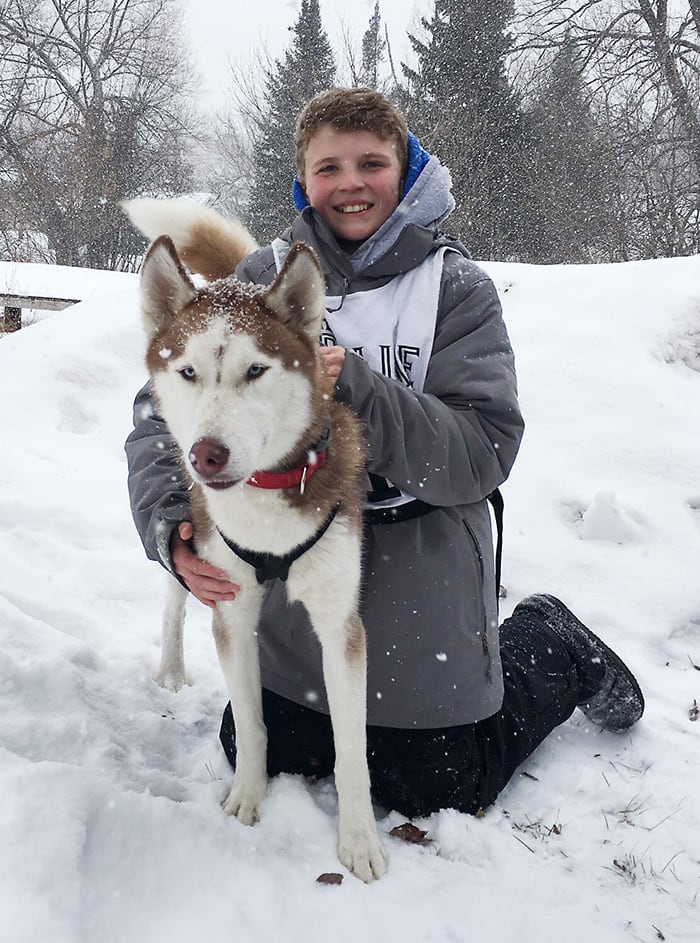
The IronLine was the first race for both Dominic and Nanook.
Nanook is a two-year-old red and white Siberian with incredible athletic ability. A lot of his attributes remind me of what I dealt with during Koivu’s (my original Siberian) first two years. He has tons of energy, a nose for trouble and is seemingly never able to tire.
I wanted to have two teams that were even in speed so we could run the race near one another. I did this for two reasons:
- This was Dominic’s first race and I wanted to ensure that he had a smooth and fun experience while out on the trail. I had all the faith in him that he could handle a team without my help, but I still wanted to be nearby just in case something extremely out of the ordinary happened.
- At the time of the IronLine, we were entered in our biggest race of the season — the Midnight Run in Marquette, Michigan, and I wanted to keep a close eye on the dogs that I planned to use for that race. The IronLine was Nanook’s first race, and I wanted to see if he performed as well in a race as he did in training before running the 90-mile Midnight Run. (Editor’s note: Due to a minor toe injury, the Breakaways were forced to pull out of the Midnight Run.)
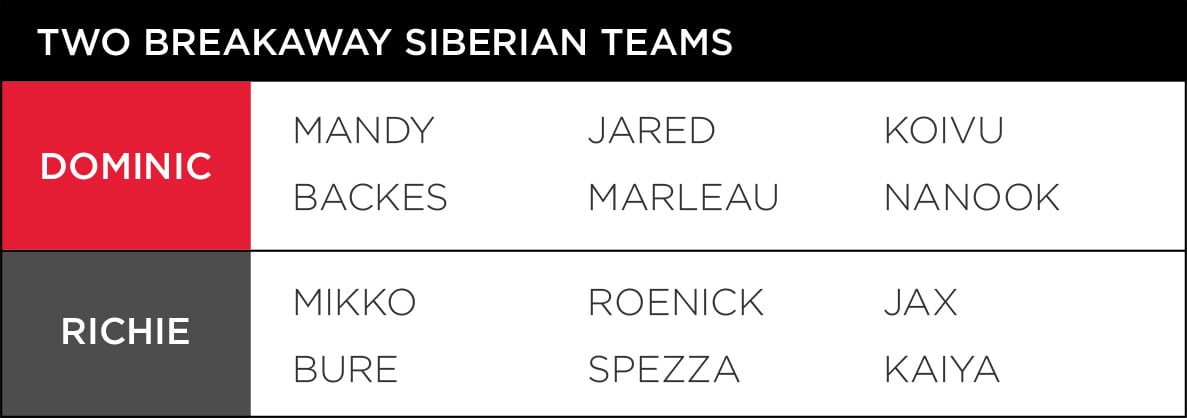
After our teams were entered, we were given a time for our “vet checks.” Vet checks are when each dog is thoroughly inspected to make sure they are healthy and fit enough to run. Our vet checks went smoothly, and all of our dogs passed. They were given a red mark of paint on their front shoulders. This is so race officials know that each dog was examined and passed their vet check. If a dog had failed the vet check, they would be given a different color and marked on their foreheads — and they would not be allowed to do the race.
A Symbolic Draw
The bib draw is a nerve-wracking event where each musher’s name is drawn randomly to determine his or her starting spot for the race. During most races, teams leave in two-minute intervals.
The six-dog race began with bib number 10. I drew bib 13, which meant I would be the fourth team to leave the chute. Dominic drew bib 15, the same number I wore during my first sled dog race. I was thankful that my team would leave first, because I would be able to stop and wait for Dominic. The dogs do not like stopping during races, so it made it easier that I would be the team stopping and waiting instead of Dominic.
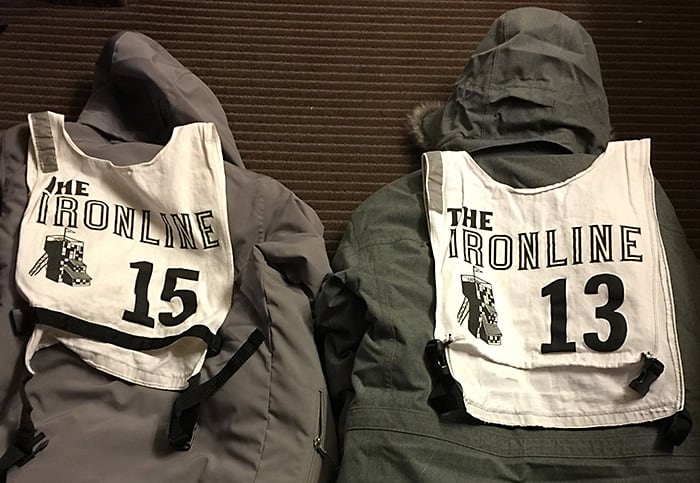
Richie was happy that his bib number was close to Dominic’s.
As the race neared, Dominic — normally a very talkative kid — began to grow more and more quiet. I asked how he was feeling, and he admitted to being nervous. Before every race I get incredibly nervous as well (as do most mushers). I did my best to calm Dominic’s nerves and also remembered to try and take my own advice. I told him to relax and remember the dogs are going to run the same way they do during the training runs.
But Dominic had a little more to worry about than I did. This was his first time ever being on a sled. Six years ago, I found myself in the exact same situation: about to start a race without ever having been on a real dogsled before. It’s not something I recommend, but in Missouri we don’t exactly get much snow to practice on!
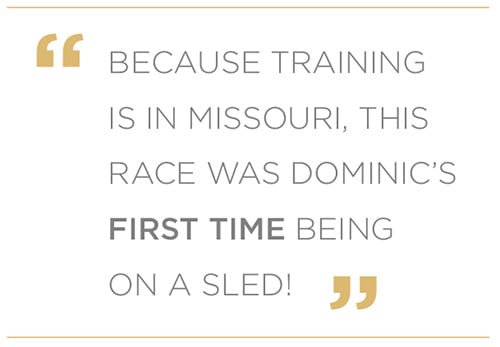
Calming the nerves
When we arrived at the race, it was still daylight. We began setting up our equipment, and I gave him an overview of the sled. The brake, the claw brake, the drag mat, how to lean, how to balance, how to turn, how to kick, how to run and the most important piece of advice, “Never ever let go of the sled.” The 13-year-old nodded in silence as he tried to take it all in. “You’ll be okay. I’ll be out there with you,” I reminded him.
During the official equipment check, I talked to Dominic more and tried to calm his nerves one last time. Before a race starts, it is complete madness. You are running around trying to hook your team up in time to make it to the chute. You don’t want to hook up too early because the dogs go nuts if the wait is too long. After all, they are more excited than anyone for the race!
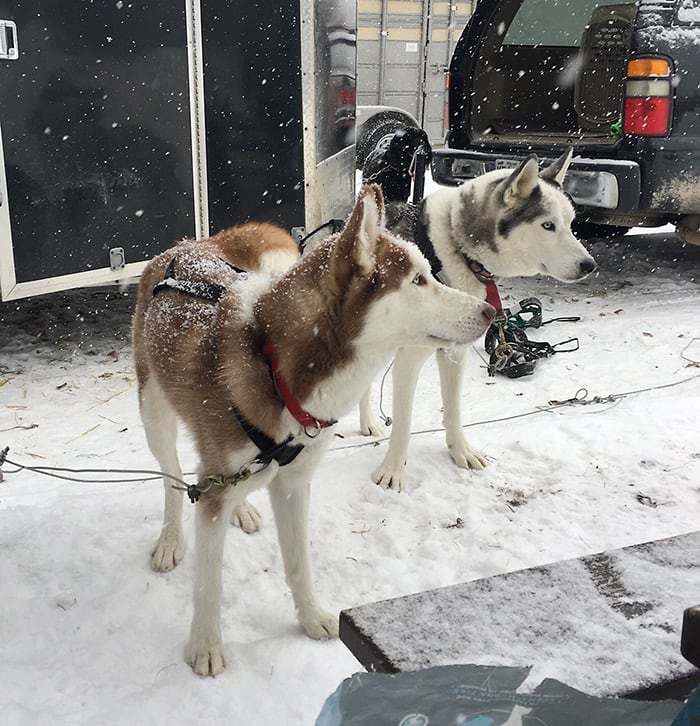
By now it was completely dark. We flipped our headlamps on and finished getting our teams ready. More volunteers arrived and helped walk my team to the starting chute. The snow around the chute was glowing purple because of buried neon lights. The crowd was so loud I could barely hear our introduction.
“You leave in one minute,” the timer told me.
I just nodded. I turned on my GPS so I could keep track of our mileage, average pace and other statistics that I try to keep track of after each run.
“Thirty seconds,” he said, still watching his clock.
The other volunteers were all holding my sled back. My team was screaming with excitement, ready to go. I could see the tension on the sled as it slowly rocked forward.
“10 . . . 9 . . . 8 . . . 7,” the countdown began.
“3! 2! 1!” The crowd joined in for the last few numbers.
“Go!” the announcer shouted.
And we shot forward at a blistering pace. I slammed on the brake, trying to slow the team down. For the first few miles, the dogs are all adrenaline. My goal is to try to keep them at their comfort pace. If it was their choice, they would try to run the race at 900 miles per hour. So I continued to press the brake down and slow the team. I let them run up a long, steep hill, and at the top I stopped the team and waited. Dominic should have been about four minutes behind me. But when you are in a race and trying to keep six excited huskies calm, it seems like four hours.
Eventually, I saw Koivu’s flashing green collar. Dominic caught up so we were nearly running side by side. I asked if everything went okay with his start, and he said it went good. I would eventually hear from Dominic’s mom that after watching his team take off into the night, she had a moment of panic where everything set in. She had just sent her 13-year-old son out into the pitch black, riding on a sled being pulled by a bunch of crazy huskies!
Underway!
Our teams cruised together through the woods, illuminated by our headlamps. Kaiya and Jax kept up a quick pace, and Dominic’s team settled in behind ours. We neared the halfway point, a golf course clubhouse. We cruised past Dominic’s parents as the crowd cheered the teams on. It was at this moment his parents were finally able to relax as they saw both teams running together and moving down the trail at a steady pace.
By now, we were in last place. The teams from the 10-dog race were passing us, and each time it amped up our dogs to speed up and try and keep up with the fast teams. But once again we would find ourselves slowing the teams down to their comfortable pace.
After almost four hours, we headed down the final halfway stretch and could see lights of the city. My team crossed the finish line first and Dominic’s team crossed seconds later, each of us with six happy and healthy dogs. For the dogs, it was a job well done and now time to get paid for their work. We dished out the food bowls filled with Diamond Naturals kibble soaked with water, meat juice and a few chunks of meats and fats. After a long run, it’s important to keep their hydration up and get as many calories back into them as possible. And with that mix, it’s not too difficult to convince them to eat and drink!
After looking over their paws, legs and muscles, it was time to bed them down, and we went to get some sleep of our own.
The second half
The next morning, we started over again. We made a few lineup tweaks to Dominic’s team, but they were once again led by Nanook and Koivu. Koivu has been the lead dog for every first-time racer that has ever been on a sled with the Breakaway Siberians team.
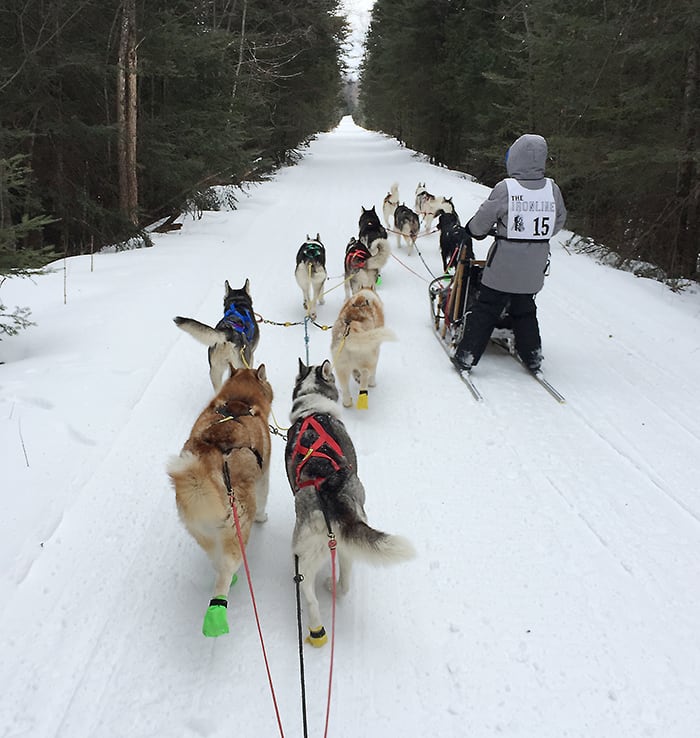
Dominic sets the pace on day 2.
This time Dominic’s team set the pace and we followed. One of Koivu’s best traits is that he runs around 8 mph almost all of the time. Nanook settled into the same pace, and the two plowed ahead and never looked back. Even though it had been less than 12 hours since they finished their first 28-mile run, we finished at a faster overall pace on day 2.
56 miles of success
With a successful half under his belt, Dominic could finally enjoy himself and take in all the beautiful sights. It even began to snow as we neared the finish line. He crossed first and we came across only seconds behind. Together, we had completed the longest race of our careers at 56 miles. We gave Dominic the Red Lantern (the award given to the last place team) for his memories (and because I’m not sure if our bookshelf can hold any more red lanterns!)
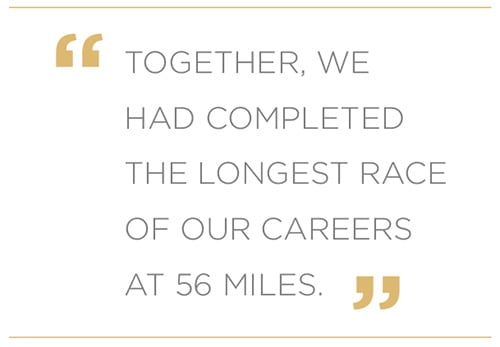
Everybody finished the race happy, healthy and ready to eat! Back at the car, we were swarmed by volunteers and photographers — most of whom were interested in hearing from Dominic, the race’s youngest musher. One volunteer asked for his photo and said, “I got one with the oldest musher in the race and now I got one with the youngest!”
It was the end of a very successful race for our team. And possibly the beginning of a career for an up-and-coming young musher wearing bib #15.
***
Due to a number of factors ranging from a minor toe injury to one of the dogs to disagreeable weather, the IronLine was the only race that the Breakaway Siberians participated in during the 2017 season. However, just by completing the 56-mile run, their longest ever, the team counts the 2017 racing season as a major success.

